


Energy Efficient
Industrialized Housing Research
Summary of FY 1998 Activities
(July 1998 - August 1999)
FSEC-CR-1111-99
November 1999
Florida Solar Energy Center (FSEC)
A Research Institute of the University of Central Florida
1679 Clearlake Road
Cocoa, Florida 32922
FSEC University of Central Florida Account No. 26-58-818
U.S. Department of Energy Contract No. DE-FC51-94R020277
By:
Janet McIlvaine
David Beal
Subrato Chandra
Armin Rudd
Brian Fuehrlein
Matthew McCloud
TABLE OF CONTENTS
Acknowledgements
Introduction
and Summary
Task1. Energy-Efficient
and Healthy Houses
Entry
Level Housing
1997 Orlando
Health House®
New
Holly Park
Task2. Whole-House
Testing and Research
Centex
Homes - Dallas, TX
Centex
Homes - Sarasota, FL
Nationwide
Modular Homes - Raleigh, NC
Red Geranium -
New Harmony, IN
Task3. Innovative
Building Components Development
FanRecycler
Metal-Wood
Framing Members
Task4. Residential
Design Assistance Center (Habitat)
Design
Reviews
Construction
Site Hands-on Training
Training
Workshops and Seminars
Field
Evaluation of Energy Conservation Concepts
Task5.
Manufactured Housing
Partnership
with Palm Harbor Homes
Manufactured
Housing Research Alliance
This research was sponsored by the U.S. Department of Energy (DOE), Office of Building Technology, State and Community Programs - Energy Efficient Industrialized Housing Program. We appreciate the encouragement and support of our Program Manager, Mr. George James.
The DOE funding was received as a subcontract from the University of Oregon (UO253368C).
We are grateful fo our collaborators - Palm Harbor Homes, Habitat for Humanity, American Lung Association affiliates, Structural Insulated Panel Association, homeowners, and others who made this work possible.
The Lawrence Berkeley National Laboratory (Mr. Al Hodgson) performed
the analysis of the gas samples to determine the volatile organic
compound levels.
The objectives of this work are to increase the market share of energy-efficient housing by conducting field testing and monitoring, research, development, design assistance, and training activities in partnership with housing manufacturers, production builders, non-profits and related members of the housing industry.
With FY98 funding, activities were conducted under five tasks. The progress in each task is summarized below:
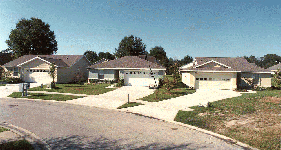 Task1.
Energy-Efficient and Healthy Houses: Testing was completed
on three side-by-side entry-level homes of identical floor plan
in central Florida. All three homes were Energy Star homes. The
home on the right is made of concrete blocks and served as the
base case. The middle home is made of autoclaved aerated concrete
(AAC) blocks and incorporated features to improve the indoor air
quality (IAQ). The third home was made of 2x4 frame construction
and incorporated features to improve the energy efficiency (Figure
1).
Task1.
Energy-Efficient and Healthy Houses: Testing was completed
on three side-by-side entry-level homes of identical floor plan
in central Florida. All three homes were Energy Star homes. The
home on the right is made of concrete blocks and served as the
base case. The middle home is made of autoclaved aerated concrete
(AAC) blocks and incorporated features to improve the indoor air
quality (IAQ). The third home was made of 2x4 frame construction
and incorporated features to improve the energy efficiency (Figure
1).
Testing over 10 months confirmed the energy savings (about 20% over base case in the cooling season, 40% if the base case had code minimum air conditioner) for the frame home and enhanced IAQ (50% reduction in volatile organic compound levels) for the AAC home. Builder magazine printed a six page article on this project in its July 1999 issue.
One year of monitoring was completed on the 1997 Orlando Health House®. Data showed that the four-ton heat pump successfully maintained the interior conditions of this 3,520 ft2 home to 73oF as desired by the home owners during the hottest summer on record in Florida (1998). The dehumidification system was able to maintain carpet level average relative humidities below 52% for every month of the year and the asthmatic home owners are delighted with the comfort and air quality of the home.
A new program, Clean Air Florida
Homes (CAFH), was initiated in cooperation with the American Lung
Associations of central Florida and Florida (ALACF and ALAF).
Technical assistance was provided for the first CAFH under construction
in Gainesville, Florida. Technical assistance was also provided
to the ALA of Washington to improve the IAQ of six units of low
income housing in the New Holly Park project in Seattle, Washington
(http://www.alaw.org/newhollya.html).
Partners: Viking Builders, Affordable Housing Institute, American
Lung Associations of Central Florida, Florida, Oregon and Washington.
Task2. Whole-House Testing and Research:Conducted diagnostic testing and energy analysis on seven insulated concrete form (ICF) and conventional frame homes in the Dallas, Texas area. One show home for the NAHB national convention met Energy Star standards.
Conducted diagnostic tests and energy analysis on a structural insulated panel (SIP) house in New Harmony, Indiana and qualified it as an Energy Star home.
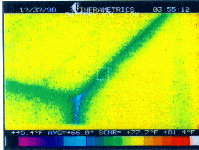 Conducted
diagnostic tests and suggested modifications in two homes experiencing
severe moisture problems in Florida (a site-built home) and
Louisiana (a manufactured home). See Figure
2 for an infrared image. Centex homes, Texas Utilities,
Masco, Palm Harbor Homes.
Conducted
diagnostic tests and suggested modifications in two homes experiencing
severe moisture problems in Florida (a site-built home) and
Louisiana (a manufactured home). See Figure
2 for an infrared image. Centex homes, Texas Utilities,
Masco, Palm Harbor Homes.
Task3. Innovative Building
Components Development: Patented and commercialized the FanRecyclerTM,
a control device to improve mixing and ventilation in homes.
Over 1,200 units were in use in FY97, many in Building America
homes. Patented innovative wood-steel framing members (with 34%
better thermal performance and equal structural performance compared
to steel-stud walls). Initiated the development of a connector
for easily attaching SIP roof panels to wall panels. See 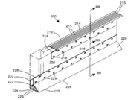 Figure
3 for an example. Partners: Triad Research, Inc.
and Lipidex Corporation.
Figure
3 for an example. Partners: Triad Research, Inc.
and Lipidex Corporation.
Task4. Residential Design Assistance
Center (Habitat): Assisted Habitat for Humanity affiliates
in constructing over 200 energy-efficient homes in Georgia, Kentucky,
New York, Ohio, Texas, and Washington. Served as the site energy
coordinator for the 100 house blitz build in Houston, Texas.
Conducted analysis and testing to assure that all 100 homes met
Energy Star standards. See Figure
4 for a picture of the volunteers. Partners: Houston
Habitat, Capitol District Habitat, Sumpter County, GA Habitat,
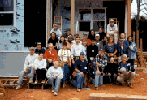 Habitat
for Humanity International, Habitat for Humanity Green Team, Southface
Energy Institute, Houston Lighting and Power, EPA Energy Star
staff, Oak Ridge National Laboratory, RCD mastic manufacturer.
Habitat
for Humanity International, Habitat for Humanity Green Team, Southface
Energy Institute, Houston Lighting and Power, EPA Energy Star
staff, Oak Ridge National Laboratory, RCD mastic manufacturer.
Task5. Manufactured Housing:
Palm Harbor Homes (PHH) now produces air tight ducts in four HUD
code home manufacturing plants in Florida, North Carolina, and
Oregon producing over 3,000 homes/year as a direct result of EEIH
project staff involvement in testing PHH model homes and training
PHH line workers. Airtightness tests in Florida show the potential
for saving 7% of heating and cooling energy in each home. Conducted
energy analysis for PHH North Carolina plant which resulted in
the first routine production of Energy Star manufactured homes
from January 1998 at a production rate of approximately 560 Energy
Star homes/year. Assisted PHH in developing options on more than
50 models to meet Energy Star standards in Alabama, Colorado,
Florida, Kansas, North and South Carolina, Ohio, Oklahoma and
Texas. Tested the air tightness of a new furnace to duct assembly
system in the PHH Buda, Texas manufacturing plant. 
Provided
funding to the Manufactured Housing Research Alliance (MHRA)
who, with co-funding from HUD, Manufactured Housing Institute,
and MHRA, developed a preliminary guide entitled "Eliminating Moisture Problems in Manufactured
Homes". This documents several case studies of moisture
problems in manufactured housing and provides checklists for
manufacturers, site installers and homeowners to avoid moisture
problems. See Figure
5 for a picture of the Plant City, FL factory. Partners:
Palm Harbor Homes, Manufactured Housing Research Alliance.
Task 1. Energy Efficient and Healthy Houses
The objective of this task was to assist in the design and construction of energy efficient and healthy homes to overcome the common perception that energy efficient homes lead to poor indoor air quality. Long term monitoring was done on several homes to document the performance of energy and health related characteristics. The following projects were completed.
- Entry Level Housing (in cooperation with Viking Builders and the Affordable Housing Institute)
- The 1997 Orlando Health House® (in cooperation with the American Lung Association (ALA) of Central Florida)
- The New Holly Park (in cooperation with the ALA of Washington)
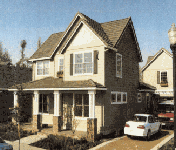 In
addition, FSEC provided design assistance and diagnostic testing
for the Healthier Home project of the ALA of Oregon in Portland,
Oregon (Figure 6).
FSEC
In
addition, FSEC provided design assistance and diagnostic testing
for the Healthier Home project of the ALA of Oregon in Portland,
Oregon (Figure 6).
FSEC 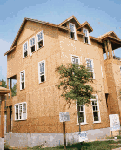 researchers
also teamed with ALA of Central Florida and ALA of Florida on a
new program, Clean Air Florida Homes (CAFH), providing technical
assistance for building in a hot, humid climate. The first CAFH
currently under construction in Gainesville, Florida (Figure
7).
researchers
also teamed with ALA of Central Florida and ALA of Florida on a
new program, Clean Air Florida Homes (CAFH), providing technical
assistance for building in a hot, humid climate. The first CAFH
currently under construction in Gainesville, Florida (Figure
7). Introduction
Homes of 1200 square feet or smaller make up 8-10% of U.S. housing start. (Census, 1997) Characterized by high occupant density, these homes accrue energy expenses that rival mortgage payments. Responding to consumer demand for lower operating costs, builders have typically reduced infiltration (tightened) and increased insulation. These efforts have netted homeowners both lower utility costs and more comfortable living conditions. However, consumer confidence in these strategies has been eroded by implications that very tight homes have poor indoor air quality.
To demonstrate both energy efficiency and healthy construction in the entry level housing market, FSEC partnered with a Central Florida contractor to design and build three 1,228 ft2 (Figure 8) homes. All three homes qualify for the Energy Star designation. One has extra energy features and another has indoor air quality features. FSEC conducted testing to evaluate several indoor air quality parameters as well as monitoring the energy use of the homes before occupancy.
After completion in August of 1998, the three houses sold immediately illustrating the high market potential of super efficient entry level housing.
Characteristics of the Homes (Table
1) 
 The
three neighboring homes, built with identical floor plans (Figure
9) and slightly different roof lines, have similar solar heat
gain characteristics and conventional regional characteristics
such as slab on grade foundations. Several improvements on conventional
practice were incorporated into all three homes to bring them
up to Energy Star status. Extensive sealing of both the duct system
(Figure 10)
and penetrations in the air barrier (Figure
11) reduce cooling loads. The air conditioning are all high-efficiency
(SEER 12, HSPF 7.5) heat pumps. To minimize the impact of return
side leaks, the air handler is located inside the conditioned
space (Figure 12).
The
three neighboring homes, built with identical floor plans (Figure
9) and slightly different roof lines, have similar solar heat
gain characteristics and conventional regional characteristics
such as slab on grade foundations. Several improvements on conventional
practice were incorporated into all three homes to bring them
up to Energy Star status. Extensive sealing of both the duct system
(Figure 10)
and penetrations in the air barrier (Figure
11) reduce cooling loads. The air conditioning are all high-efficiency
(SEER 12, HSPF 7.5) heat pumps. To minimize the impact of return
side leaks, the air handler is located inside the conditioned
space (Figure 12).
Each of the three homes features a different structural system
(Figure 13)
to illustrate that energy efficiency can be achieved in this market
with conventional materials (concrete block and
 wood
frame) as well as with innovative systems such as autoclaved aerated
concrete blocks (AAC). Though this dissimilarity demanded different
types and levels of wall insulation, all three homes scored above
86 on the Home Energy Rating System (HERS) scale, the Energy Star
Homes threshold.
wood
frame) as well as with innovative systems such as autoclaved aerated
concrete blocks (AAC). Though this dissimilarity demanded different
types and levels of wall insulation, all three homes scored above
86 on the Home Energy Rating System (HERS) scale, the Energy Star
Homes threshold.
The wood frame home incorporates an attic radiant barrier (Figure 14) and high performance windows for additional energy saving features. These features reduce two of the largest air conditioning loads in Central Florida homes: radiant heat gain via the roof and windows.
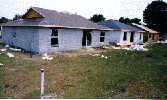 The
AAC home showcases a variety of low VOC (volatile organic compound)
building materials and a fresh air ventilation system (Table
1). For example, the low emission
The
AAC home showcases a variety of low VOC (volatile organic compound)
building materials and a fresh air ventilation system (Table
1). For example, the low emission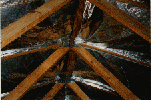 carpet (100% nylon) carries the Carpet and Rug Institute's Green
Seal. The fresh air ventilation system draws outside air into
the air handler's return plenum through a dedicated duct. Thus,
ventilation air is being introduced from a known source through
a designed air flow path. Planned ventilation provides much cleaner
air than unplanned infiltration. Fresh air isn't pulled through
unintentional cracks in the building envelope where it can pick
up small particles of building materials, various gases from combustion
appliances or chemicals in building materials. Consequently, building
cavities (like walls) aren't exposed to unconditioned air and
damaging humidity. Another ventilation feature of the AAC house,
the FanRecycler, (Figure
15) circulates indoor air through the duct system by switching
the air handler fan on even if the conditioning system isn't operating.
This improves indoor air quality by dissipating high concentrations
of humidity and providing fresh outdoor air even during hours
when neither air conditioning nor heating is called for. During
these periods, slow wind speed, lack of cross ventilation, closed
interior doors and
carpet (100% nylon) carries the Carpet and Rug Institute's Green
Seal. The fresh air ventilation system draws outside air into
the air handler's return plenum through a dedicated duct. Thus,
ventilation air is being introduced from a known source through
a designed air flow path. Planned ventilation provides much cleaner
air than unplanned infiltration. Fresh air isn't pulled through
unintentional cracks in the building envelope where it can pick
up small particles of building materials, various gases from combustion
appliances or chemicals in building materials. Consequently, building
cavities (like walls) aren't exposed to unconditioned air and
damaging humidity. Another ventilation feature of the AAC house,
the FanRecycler, (Figure
15) circulates indoor air through the duct system by switching
the air handler fan on even if the conditioning system isn't operating.
This improves indoor air quality by dissipating high concentrations
of humidity and providing fresh outdoor air even during hours
when neither air conditioning nor heating is called for. During
these periods, slow wind speed, lack of cross ventilation, closed
interior doors and  closed
windows (for security) hinder natural ventilation. Closed interior
doors can also impede proper conditioning by restricting flow
of return air from private rooms. This creates infiltration induced
by pressure imbalances subsequently placing greater loads on the
conditioning system. To overcome this, through the wall registers
above bedroom doors allow free air flow bringing the conditioned
space back into pressure balance.
closed
windows (for security) hinder natural ventilation. Closed interior
doors can also impede proper conditioning by restricting flow
of return air from private rooms. This creates infiltration induced
by pressure imbalances subsequently placing greater loads on the
conditioning system. To overcome this, through the wall registers
above bedroom doors allow free air flow bringing the conditioned
space back into pressure balance.
Post Construction Evaluation
After carefully monitoring the construction process, FSEC conducted a standard battery of testes to evaluate several energy and indoor air quality performance indicators. Two measurements, whole house and duct air tightness, are used in the Energy Star rating process. Results from these tests, the final Energy Star ratings, measured natural ventilation rates (SF6 tracer gas decay method) and concentrations of volatile organic compounds (VOCs) including formaldehyde, are summarized in Table 2.
Air Conditioning Energy Use
FSEC requested and received permission from the new homeowners
to monitor the energy use in all three homes. Since the homes
were not occupied immediately, FSEC researchers were able to monitor
air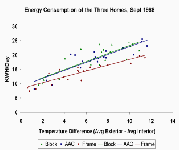 conditioning energy use for one month under carefully controlled
operation. During this period, the Frame House consumed about
20% less energy than the AAC house and the Block House (Figure
16). This supports the higher rating, or predicted energy
performance, of the Frame House with it's important extra energy
features. In the AAC house, the energy used by the mechanical
ventilation system offset some of the energy savings from the
double pane windows and higher R-value wall. Note that if the
Frame and AAC houses were compared to a conventional block house
with a lower, standard efficiency air conditioner, they would
likely have saved 40% and 20% respectively. These figures bear
great potential for the entry level housing market.
conditioning energy use for one month under carefully controlled
operation. During this period, the Frame House consumed about
20% less energy than the AAC house and the Block House (Figure
16). This supports the higher rating, or predicted energy
performance, of the Frame House with it's important extra energy
features. In the AAC house, the energy used by the mechanical
ventilation system offset some of the energy savings from the
double pane windows and higher R-value wall. Note that if the
Frame and AAC houses were compared to a conventional block house
with a lower, standard efficiency air conditioner, they would
likely have saved 40% and 20% respectively. These figures bear
great potential for the entry level housing market.
Monitoring of energy use under occupant controlled conditioned commenced on October 1, 1998 in the Frame and Block Houses and on November 1, 1998 in the AAC House and continued until June of 1999 for a total of ten months of data. The occupant of the Block House and the three occupants of the Frame House were usually away from home during the day. While at least one of the six AAC House occupants was usually home.
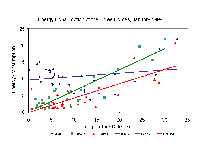 During
the Winter portion of the occupied monitoring period (Figure
17), the Frame house continued to consume less energy than
the Block house, even though the Frame home was kept warmer.
During
the Winter portion of the occupied monitoring period (Figure
17), the Frame house continued to consume less energy than
the Block house, even though the Frame home was kept warmer. 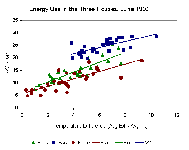
During the Summer portion of the occupied monitoring period (Figure 18), the differing internal heat gain load (6 occupants) results in higher consumption in the AAC house. Note that, compared to the Block house, the frame house continued to consume less energy despite a higher occupancy load.
In summary, the Frame house consumed 19.7% less energy than the AAC house and 20.8% less energy than the Block house during the unoccupied monitoring period of September 1998. During the occupied period of June 1999, the Frame house consumed 30.1% less energy than the AAC house and 22.5% less energy then the Block house.
Economics
The additional cost of the high efficiency air conditioners (20% better than standard efficiency) was about $300. This element has very attractive, highly marketable appeal and payback. Actual costs for the upgrades in the Frame House exceeded $2,000. Maximum possible savings due to these items is estimated to be about $72/year, assuming an electric rate of $0.08/kWh, resulting in a payback period of close to 35 years. Research is needed to develop more cost- effective envelope improvement strategies.
The indoor air quality improvements in the AAC House totaled about $2,000. While the qualitative nature of these improvements makes calculating a payback impossible, medical savings are a possible avenue for recouping this type of investment. Though a larger sample of families would be needed to assess potential savings, the homeowner in the AAC House reports that her son requires much less allergy medication since moving into the house.
Anecdotal evidence suggests this would be a valid avenue for further research and one in tune with home buyer interest. While a survey of 80,000 households by Contracting Business Magazine found that 46.6% of respondents cited energy cost as the first concern when purchasing a conditioning system (ACCA, 1999.) 33.8% cited indoor air quality as the improvement they most wanted. 54.8% of the group said that if they were purchasing a new home, that air [quality] features, such as those in the AAC House, would be purchased.
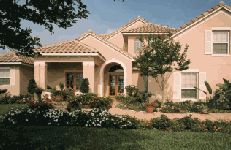 The
1997 Orlando Health House® (Figure
19) was built by Sunscape homes in partnership with the American
Lung Association of Central Florida and FSEC. The design goals
for the house were based
The
1997 Orlando Health House® (Figure
19) was built by Sunscape homes in partnership with the American
Lung Association of Central Florida and FSEC. The design goals
for the house were based
upon four organizing principles:
Minimize dust and pollens inside the house.
Control indoor humidity year round to
50% (RH) or lower.
Choose products to minimize the emissions
of volatile organic compounds (VOC).
Use energy-efficient design, components,
and mechanical systems.
FSEC generated technical specifications for the house and performed
a plan review to assure compliance with the stated design goals.
FSEC designed the overall heating, ventilation and air conditioning
(HVAC) system and provided the patented FanRecycler®, a device
to improve the indoor air quality. FSEC suggested sources for
products and acquired several product donations.
During construction, FSEC personnel made weekly visits to aid
the builder and try to forestall any problems or design failures.
After the HVAC duct system was installed, but prior to drywall
hanging, a site
visit was made to test the duct system integrity. When the building
was completed FSEC conducted a building envelope test and a duct
system test to insure that the design goals were met. Temperature
and
humidity monitoring equipment was placed in the house to monitor
the interior temperature and humidity at the carpet level, the
attic temperature and humidity.
Specific features in the 1997 Orlando Health House used to meet the design goals are:
Foundation Moisture Control (Figure 20)
The house uses foam sealing for all vapor barrier penetrations to reduce moisture seepage from the ground.
 Insulation
(Figure 21
and Figure
22)
Insulation
(Figure 21
and Figure
22) 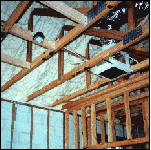
A spray foam insulation was applied in frame walls, kneewalls,
and most innovatively, under the roof deck. This resulted in a
completely sealed and semi-conditioned attic space (contrasted
to vented attic
spaces which are hot and harbor dust and moisture).
The entire Health House performs like a bubble, protecting the occupants and their belongings from the intense Florida heat, humidity, dust, and pollen.
Tile Roof
Concrete barrel-tile roofing gives the Health House both beauty
and energy efficiency. The tiles significantly reduce attic temperature.
The high-profile shape of the tiles allows for good venting under
the tile,
significantly reducing attic temperature. Their large mass allows
them to absorb significant amounts of heat. The mass absorbs and
desorbs large amounts of moisture in a diurnal cycle that further
abates the
heat load in the attic.
Aerated Autoclaved Concrete (AAC)
A lightweight, energy efficient material with exceptional workability, allowing it to be cut and shaped like wood. Additionally, it is fire and termite resistant. The walls were made of AAC blocks.
Zoned Heat Pump System
The house features a heat pump with a zoned conditioning system
to provide greater comfort and enhance energy efficiency by eliminating
usage in unneeded zones. The four-ton air conditioning load on
this
3,520ft2 house is much lower than the approximate seven-ton load
of a comparably sized conventional home without energy features.
Whole House Dehumidifier/Ventilator and Air Filter
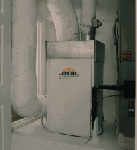 A
high efficiency dehumidifier (Figure
23), provides excellent indoor air quality. This device ventilates
and dehumidifies the home. This aids in the prevention of dust
A
high efficiency dehumidifier (Figure
23), provides excellent indoor air quality. This device ventilates
and dehumidifies the home. This aids in the prevention of dust
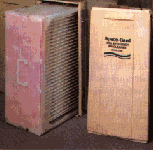
mite infestations, as well as inhibiting mold, mildew, and bacteria
growth. The air filter is a 7" thick, high efficiency filter (Figure
24) which removes airborne particles down to one micron in
size. It needs to be
changed only once or twice each year. The result is a home full
of clean, dry, fresh air.
Air Handler in Conditioned Space
The air handler and dehumidifier were located in the conditioned space for energy efficiency and improved indoor air quality.
Ducts
Tight ducts are essential to the integrity of the Health House.
Ducts are made tight by using mesh and mastic joints (Figure 25).
The return ducts are made of sheet metal for ease of cleaning.
The supply ducts
were insulated flexduct.
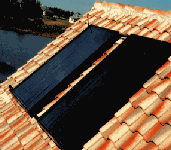 Solar
Water Heater (Figure
26)
Solar
Water Heater (Figure
26)
The abundant sunshine in Florida makes solar water heating a cost-effective choice for residents. The Health House solar system utilizes the sun's energy to significantly reduce utility costs for water heating.
Reduced VOC Emissions,
Interior paints containing no VOCs, tile floors, 100% Nylon Rugs
that feature the Carpet and Rug Institute's (CRI) "Green Seal",
and solid wood cabinets with no particleboard all reduced or eliminated
common indoor sources of pollutants.
Sealed Combustion Fireplace (Figure
27) 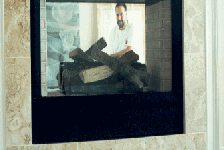
Sealed combustion gas fireplaces function independently of the
interior air eliminating the threat of harmful gasses entering
the house. They have their own combustion air supply, make up
air supply, and
exhaust system so they do not create pressure imbalances inside
the home.
Double-Pane low-E Windows form a heat-rejecting shield against Florida's intense solar gains.
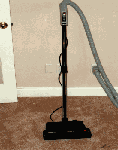 A
Central Vacuum System (Figure
28 and Figure
29) that exhausts to the outside was used to maintain the
home free of dust and dust mite allergens.
A
Central Vacuum System (Figure
28 and Figure
29) that exhausts to the outside was used to maintain the
home free of dust and dust mite allergens. 
After completion, FSEC personnel tested the building envelope
and duct system integrity with a blower door and duct blaster.
Blower door testing establishes a leakage rate for the house at
a specific
pressure (air changes per hour at 50 pascals or ACH50). Duct blaster
testing yields the leakage rate of the duct system in a similar
manner (cubic feet per minute of air leakage at 25 pascals or
CFM25).
Envelope testing of the house revealed a low ACH50 of 2.2, extremely
tight. The innovative application of spray foam insulation to
the roof deck combined with an airtight stucco wall produced this
result. A
further advantage of this construction system is that all of the
duct work above the ceiling is now in the conditioned space, meaning
that any duct leakage is to the inside of the thermal boundary.
After testing, the results were input into the Florida Energy
Gauge software to determine the Energy Performance Index (EPI)
using Florida's Energy Code and the Energy Star Rating using the
Home Energy
Rating System (HERS). The house received an EPI score of 52.6.
This score is far superior to the maximum allowable score of 100.
The HERS score of 89.6 is not only high enough to receive an Energy
Star designation but is significantly greater then the 86 required
to achieve Energy Star status.
In addition to the airtightness testing and the energy efficiency analysis, FSEC compiled a year's worth of temperature and relative humidity data measured in the attic and at the carpet level inside the house.
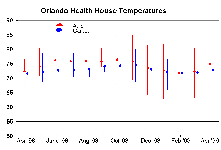 The
dehumidifier proved effective. The average house relative humidity
was always close to or lower than 50% (Figure
30), the goal laid out in the organizing
The
dehumidifier proved effective. The average house relative humidity
was always close to or lower than 50% (Figure
30), the goal laid out in the organizing 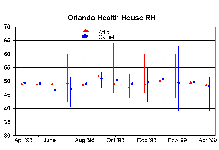 principles.
The monthly temperature averages
principles.
The monthly temperature averages
show that the HVAC system kept the house at a comfortable temperature
and conditioned the attic as well (Figure
31).
In 1997, the American Lung Association of Washington (ALAW) partnered
with the Seattle Housing Authority (SHA) to design and build several
units in their Holly Park Redevelopment project as Healthy
Houses. This effort was prompted by ALAW's Washington State Asthma
Project 1998, Task Force on Asthma and Allergies in Communities
with Increased Prevalence.
The Task Force's literature review concluded that increased health
risk appeared to be associated with being a child, being atopic
(allergic), being exposed to pollutants or allergens, and being
poor and/or an
ethnic minority. Reports from the Seattle-King County Department
of Public Health determined that in King County between 1987-89
and 1994-96 hospitalization of children due to asthma attacks
increased
25% in neighborhoods with the greatest poverty, 33% in medium
poverty neighborhoods, and 18% in low poverty areas. Further,
in 1994-96, the rate of hospitalization in high poverty areas
was 1.5 times
greater than the rate for medium poverty neighborhoods and three
times that of residents in low poverty neighborhoods. Based on
these conclusions, ALAW decided to ask the SHA to participate
in the
healthy redevelopment of the Holly Park neighborhood, feeling
that this was a significant step to aid as many potential and
present victims of asthma as possible.
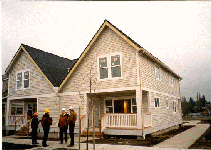 Due
to the dramatic increase of asthma in poor and/or ethnic children,
the residential child care facilities of the redevelopment were
targeted as Healthy House sites. In the redevelopment, six of
the 450 new
Due
to the dramatic increase of asthma in poor and/or ethnic children,
the residential child care facilities of the redevelopment were
targeted as Healthy House sites. In the redevelopment, six of
the 450 new
homes were designated as home-based day care facilities (Figure
32). These were five-bedroom duplexes. Children spend an average
of ten hours per day in these facilities and day care professionals
may
also have the opportunity to encourage further attention to other
factors in the child's environment that may trigger or exacerbate
the symptoms of asthma.
After a successful partnership during their first Healthy House
project, ALAW again contacted FSEC for assistance in approaching
SHA. FSEC's technical expertise proved significant in persuading
the SHA
of the need for healthy housing and the ALAW's ability to facilitate
the project. After the decision was made to proceed with the project,
FSEC was involved with the design, review, and implementation
of
the healthy features, interfacing with the ALAW, SHA, the architect,
and the builder.
The ALA of Washington is incorporating Healthy House techniques
and components into each child care unit to ensure enhanced indoor
air quality. Healthy House modifications were found to be
cost-effective alternatives for the entire New Holly effort and
were, in fact, incorporated into all the homes in Phase I. These
features include:
Construction of a continuous air barrier
to reduce air infiltration. By carefully sealing the floors, walls,
ceilings, doors, and windows, an airtight envelope was created
to provide draft-free,
energy-efficient housing with few paths
for uncontrolled air flow.
Installation of variable-speed kitchen exhaust fans to remove moisture, oils, and to improve air circulation.
Selection of low-weave, 100% nylon carpets to reduce VOC emissions. All the carpets were laid with tack strips, and used a low-VOC, recycled fiber underpad.
Use of non-toxic adhesives and finishes along with low-VOC, water-based paints to minimize chemical exposure.
In December 1998, FSEC researchers visited Seattle to test the
first child care unit for airtightness and pressure differentials.
This was important because it indicated whether combustion gases
would enter the
living space or not. The testing also determined whether there
was adequate ventilation and air circulation in the house.
The testing showed that the Healthy House child care unit performed
significantly better than the unmodified units (which were tested
by Seattle City Light). The sealed room which contained the gas
water
heater was aerodynamically uncoupled from the living space, reducing
the possibility of backdrafting combustion gases. This was true
even when all the exhaust fans (the continuously operating fan
as well as
the bathroom and kitchen ones) were turned on.
Upon testing, some additional recommendations were made:
Move the continuously operated whole-house exhaust fan from the bathroom to the hallway for improved ventilation of the whole house..
Move the CO detector to the ceiling just outside the door to the sealed room containing the gas water heater.
Along with the Healthy House enhancements to the child care units,
the American Lung Association of Washington has begun educational
outreach in the Now Holly Community by offering free indoor air
quality workshops through the Holly Park Family Center. These
workshops offer low- and no-cost ways to improve and maintain
the indoor environment. More information is available on the web
at
http://www.alaw.org/newhollya.html.
Task 2. Whole House Testing and Research
The objective of this task was to partner with builders to conduct
diagnostic tests and Energy Star Ratings of their conventional
and energy efficient homes. Projects with the following builders
were completed
and are included in this report.
Centex Homes - Dallas, TX
Centex Homes - Sarasota, FL
Nationwide Modular Homes - Raleigh, NC
Red Geranium - New Harmony, IN
This task also assisted in solving moisture and soot problems
in newly constructed homes. Diagnostic tests were conducted and
reports are available on the following three homes. The recommendations
were
implemented by the builders with excellent results.
D.W.Hutson - Problem home (soot) in
Jacksonville, FL
Palm Harbor Homes - Problem home (mold)
in Prairiville , LA
Pralle Builders + MASCO - Problem home
(mold) in Ormond Beach, FL
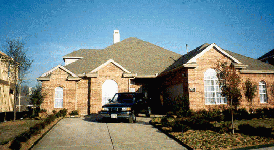 Centex
Homes, in collaboration with the Portland Cement Association,
is evaluating the costs and benefits of insulated concrete form
(ICF) construction. Over a dozen ICF and conventional (2x4 frame)
Centex
Homes, in collaboration with the Portland Cement Association,
is evaluating the costs and benefits of insulated concrete form
(ICF) construction. Over a dozen ICF and conventional (2x4 frame)
homes (Figure 33)
in the Dallas-metro area are involved in this study, a collaboration
of Centex, FSEC, and Texas Utilities.
Field Testing Procedures
Field testing results for five ICF homes and two wood frame homes
are presented in Table
3. House air tightness was measured by a computerized blower
door, depressurizing the houses. Total duct air
tightness was measured by depressurizing the ducts to -25Pa with
a duct blaster after removing all the air filters. The -25Pa was
measured at the return air grill where the duct blaster was connected.
Duct
leakage to outside was measured by maintaining a house pressure
of -25Pa with the blower door and bringing the duct to house pressure
to zero with the duct blaster. CFM50 is the combined house and
duct
system leakage as measured by the blower door when depressurizing
the houses to -50 pascals. Additional blower door tests were done
by masking off the fireplace and the exhaust fans and the recessed
ceiling lights to quantify their air leakage. The results showed
the following CFM50 air leakage values for components in the concrete
concepts house (the fifth house in Table
3).
Fireplace=358 CFM50
Four bath and laundry exhaust fans total
= 385 CFM50
13 can lights (12 to the attic) total
= 185 CFM50
Kitchen exhaust = 14 CFM50 (indicating
a good back draft damper).
Except for the fourth house, the air tightness of all houses was less than 6.0 ACH50, the average leakage measured in a large sample of new Florida homes.
Mechanical and Air Distribution Systems
The duct system consisted of flexduct supply and return runs
to attic mounted air handlers. Mastic was not used to seal the
joints. The typical duct-to-collar connection consisted of a single
strap around the
inner liner and another one around the outer liner. The two-story
houses have two duct systems and two air handlers. The Concrete
Concepts (CC) home (fifth column) had three duct systems and three
air
handlers. The leakage was measured for each duct system. The total
is reported in Table 3. The total leakage
was measured at -25 pascals and is also reported as a percentage
of the floor area. The duct
leakage of concern in terms of energy waste is the duct leakage
to outside. This is also reported as a percentage of the floor
area.
The average duct leakage in Florida homes is about 8% (leakage
to the outside as a % of floor area). Except for the CC home,
the ICF homes all had a leakage lower than that. The duct leakage
in the
conventional homes were greater than the 8% number.
Table 3 also documents two other parameters
related to whole-house performance: the presence or absence of
a radiant barrier in the attic (Solarboard) and the number of
recessed can lights exposed to the
attic.
Thermal Envelope
All houses were slab on grade with R-30 ceiling insulation. The
windows were all double pane clear with an aluminum frame (NFRC
U=0.81). The ICF walls are R-20 and the conventional frame walls
have
an R-11 insulation.
Mechanical Equipment
All houses have a programmable thermostat. Except for the CC
home, all houses have a dual fuel system with SEER 12, HSPF 7.5
heat pumps and a 80% AFUE gas furnace. Thus, two Energy Star ratings
are presented for each home, one for the gas heating system and
the other for the heat pump. The CC home has only one rating as
it does not have a heat pump.
Researchers plan to monitor energy use, temperature, and RH in at least two pairs of these homes. However, due to circumstances beyond FSEC control, the instrumentation has not yet been completed.
Recommendations
The duct system leakage is high and should be reduced by using mastic and fabglass to create an essentially leak free duct system.
Better quality bath exhaust fans (with better backdraft dampers) and air tight recessed can lights are recommended to reduce envelope leakage.
These measures will afford the opportunity to reduce the tonnage
of the air-conditioning equipment, probably paying for the cost
of the recommended improvements and making the houses more energy
efficient and healthy.
The Sarasota division of Centex homes contacted FSEC to conduct evaluation of their base case homes. In August 1999, the first set of diagnostic tests were conducted.
Two model homes under construction in the Tatum Ridge development
were inspected. The homes were 1,935 ft2 and 2,568 ft2, and were
dried-in, with the duct work rough-in completed. The duct systems
were constructed out of flex duct and sheet metal junction boxes.
The collars for the flex duct were tabbed, screwed, and bedded
in mastic where attached to the sheet metal junctions. Flex duct
to collar
connections were made with straps and tape. The smaller home used
a single large ducted return, while the larger house had a return
system, with many ducts. As the ducts were only roughed-in, minimal
testing was possible. Both supply systems showed a total CFM25
of 37. This is without the air handler. These numbers indicate
a very tight duct system at this point.
As a side note, Centex personnel showed a block wall attic insulation
baffle installation mandated by Manatee County code that was very
poor. They mandate the installation of a baffle on a block wall
that
creates an air path to the interior drywall. This could cause
damage if vinyl wall paper was installed on an exterior wall.
If the baffle was installed as instructed by the manufacturer,
all would be well.
Nationwide Modular Homes - Raleigh, NC
The purpose of this activity was to conduct house air tightness testing of two modular homes using different air sealing techniques at the marriage wall but otherwise identical.
Two new, unoccupied modular homes manufactured by Nationwide
Homes were tested. Both homes were of identical floor plan: a
three-bedroom, two-bath, 1,440 ft2 model called Southport II.
These
were single-story, two-section homes joined at the marriage line
by two different techniques. One home was sealed by an expanding
foam sealant at the marriage line after the sections were set,
and the other
by a P shaped foam gasket with a 1.38" diameter bulb and a stapling
flange attached at the factory.
House airtightness was measured by a calibrated blower door using an automated controller to conduct multiple point tests. The results are tabulated in Table 4.
The test results indicate that the house with the expanding foam
seal was significantly tighter than the other house. Inspections
under the house in the crawlspace revealed that foam sealant was
thoroughly
applied. The house with the "P" gasket had some areas where the
gasket was permanently crushed and did not fully recover. In the
attic, the gasket did not fully fill the marriage wall gap for
about 20% to
25% of the length. Under the house, the gasket fell from the wall
gap in some places and was manually pushed back in. A retest showed
that this eliminated about 40 CFM50 in air leakage. The house
with
the "P" gasket had air ducts which were better sealed with mastic
at the return. The carpets, carpet pad, and baseboard trim were
not installed at time of testing; however, smoke tests did not
reveal significant
air leaks at these sites.
In conclusion we found that the house with the "P" gasket had
more air leakage than the other house sealed with site applied
expanding foam. For comparison, the ACH50 numbers for these houses
(5.85 and
7.58) were both tighter than the average tightness of 7.8 ACH50
measured for 20 recently built manufactured homes in North Carolina.
A more flexible and perhaps larger gasket which is nailed in with
large-head nails may improve the air tightness further.
Red Geranium - New Harmony, IN
Red Geranium Enterprises, under the leadership of Mrs. Jane B.
Owen, financed the construction of the New Harmony House. The
house was designed by Mr. Roger Rasbach and built by Jeffrey A.
Koester Construction Co. in the summer of 1998. The 1,080 ft2,
slab-on-grade house is built with structural insulated panel (SIP)
walls and roof. It features vaulted ceilings with the air and
thermal barrier at
the roof line. The air handler unit and the duct work are both
located in an attic space within the air and thermal boundary.
The house features low-E windows, low-e interior paint, and a
detached garage. A
high efficiency heat pump and a direct vent gas fireplace provide
heating and cooling. The house also features recycled roofing
shingles, recycled decking, and other resource efficient materials.
It is an Energy
Star home with an FSEC calculated rating of 87.4.
Blower door tests and infra red scans were done to identify potential
thermal shorts. House airtightness was measured by a computerized
blower door, depressurizing the house. Since the ducts are in
the
conditioned space, the duct leakage to outside is zero. The total
duct leakage could not be measured as one of the larger returns
could not be taped, being partially blocked by a built in desk.
The blower door results indicated a very tight house. The measured
leakage at 50 pascals was only 437 cfm which translates to an
air change rate of 2.4 at 50 pascals (2.4 ACH50). This is much
lower than
the average air change rate of 6 ACH50 found in new Florida homes.
In fact, this is lowest air change rate we have measured to date
in terms of absolute cfm of leakage in a house.
 Infrared
scans confirmed the low air leakage. While there were a few cold
spots (e.g. near the floor behind the kitchen cabinets, at the
intersection of windows and walls, wall corners, panel joints
at gable
Infrared
scans confirmed the low air leakage. While there were a few cold
spots (e.g. near the floor behind the kitchen cabinets, at the
intersection of windows and walls, wall corners, panel joints
at gable
ends etc.) as to be expected in any construction, the size of
the cold spots did not increase when the house was depressurized.
Infrared images show a very tight joint at the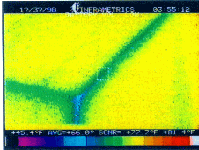 corner of the bedroom before
corner of the bedroom before
depressurizing (Figure
34), and after five minutes at -50 pascals
(Figure 35). These infrared images indicate a small thermal short (the blue and green areas) which did not grow substantially after the house was depressurized.
Recommendations
The duct system was assembled without any mastic. In this house,
the ducts are within the thermal boundary so there is no energy
loss due to duct leakage. However, in general, for duct systems
in
unconditioned attics or crawl spaces, we highly recommend sealing
the ducts with mastic and fabglass to assure an air tight air
delivery system.
The annual air change rate for this house under normal weather
conditions is estimated to be only 20 CFM. Supplementary mechanical
ventilation is essential in this house if it is to be lived in.
Mr. Koester was
well aware of this and pointed out that except for occasional
guests, the house will remain unoccupied as a demonstration house.
Task3. Innovative Building Components Development
Development and commercialization efforts continued on two series of components:
The FanRecycler® line of controllers
to improve indoor air mixing and ventilation
Metal-wood framing members
In 1992, Armin Rudd of FSEC conceived of a fan control that would
work with any central heating and cooling system by automatically
activating the central air handler fan if it had been inactive
for a period
of time. This achieves effective and economical air mixing and/or
ventilation air distribution using the existing central fan and
ducts without continuous or redundant fan operation. U.S. Patent
5,547,017 was
issued for the system in August 1996. In April 1997, contracts
were made with two licensees. U.S. Trademark 2,233,686 was registered
in March 1999.
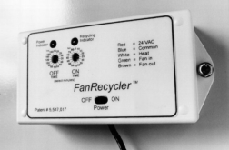 First
commercially applied at the Prairie Crossing, Grayslake, Illinois
development as part of the Building America Program, FanRecycler
(Figure 36)
is now a key component in central-fan-integrated
First
commercially applied at the Prairie Crossing, Grayslake, Illinois
development as part of the Building America Program, FanRecycler
(Figure 36)
is now a key component in central-fan-integrated
ventilation systems in homes throughout the U.S. and Canada. More
than 1,200 FanRecycler units are currently in use and it is available
commercially from Shelter Supply, Inc. (Lakeville, MN).
A second innovative control added the ability to control an outside
air damper, so only the design ventilation air flow is delivered
regardless of how long the central system fan operates by thermostat
demand.
In March 1999, U.S. Patent 5,881,806 was issued for this second
control and a prototype was constructed by Lipidex Corp (Duxbury,
MA)
For residential and some light commercial construction, solid
wood timber is the primary framing material. However, large timber
for lumber is becoming more scarce, the quality is declining,
and the cost is
volatile and generally increasing. Alternatively, the availability
of steel is high, the quality is consistent, and partly due to
recycling and new manufacturing technology, the cost of steel
is on a stable or downward
trend. Consequently, use of steel framing in residential and light
commercial construction is increasing, and according to several
studies cited by Random Lengths, the rate at which lumber is being
used in new
homes has been declining for a decade.
According to the National Association of Homebuilders (NAHB),
lumber prices have increased dramatically in the past decade,
making new homes less affordable. The American Iron and Steel
Institute
(AISI) and the NAHB Research Center state that the cost of lumber
has exceeded the breakeven point between wood and steel framing
many times in recent years, by as much as 40%. In a 1994 survey
of
561 builders, 64% considered lumber price and availability to
be the most significant issue facing them. Eleven percent were
already using steel framing and 34% planned to use it.
In 1998, the AISI established the North American Steel Framing
Alliance with a specific goal to rapidly accelerate the use of
light gauge steel framing in residential construction. The National
Manufactured
Housing Alliance has convened a Steel Framing Committee to examine
the viability of using steel framing for manufactured homes.
The major energy disadvantage of steel framing, relative to wood
framing, is the higher thermal conductivity of steel. Unless expensive
insulated sheathing is used, increased energy consumption for
space
conditioning will result. A readily observable dust marking or
"ghosting" may develop on the interior finish material showing
the outline of the colder framing member behind. Another drawback
is the increased
potential for moisture condensation both in the framed cavity
and on the surface of the interior finish material.
Metal and wood composite framing members can be used in place
of conventional wood framing members such as: 2x4 and 2x6 wall
studs, and 2x8, 2x10, 2x12 and other dimensions of roof rafters,
floor
joists, and headers. They can be used to replace similar sizes
of conventional light-gauge steel framing to reduce thermal transmittance
and sound transmission. Metal is utilized for its high strength,
consistent
quality, cost stability, potentially lower cost through recycling,
and resistance to rot, fire, and insects. Wood is used
primarily for its lower thermal conductivity, and common availability. The metal components form the primary structure while wood provides some structure and a thermal break.
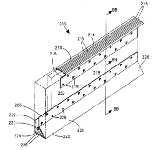 Armin
Rudd while at FSEC patented four such configurations of metal
and wood composite framing members. These U.S.Patents were granted
in March, 1999 and are numbered 5,875,603; 5,875,604;
Armin
Rudd while at FSEC patented four such configurations of metal
and wood composite framing members. These U.S.Patents were granted
in March, 1999 and are numbered 5,875,603; 5,875,604;
5,875,605; and 5,881,529. These innovative building technologies
are at the beginning stages of development for market readiness.
In a nutshell, these framing members bridge the gap between steel
and
wood framing by utilizing the individual strengths of each material.
Steel is strong, straight, and has a stable price, while wood
resists heat transfer and is more available, easily machinable,
and renewable.
Metal that can be used includes roll formed steel approximately
18-22 gauge. The invention (Figure
37) connects J-shaped or triangular shaped metal forms to
wood sections. The metal flange ends can have
various J, C, L, right triangular, triangular, T and straight
line cross-sectional shapes. The wood is fastened to the metal
by machine pressing the metal to the wood. Alternatively, mechanical
fasteners such as
nails, staples or screws can be used. Adhesives provide a third
fastening option. The outward faces of the metal members are pre-formed
with four longitudinal ridges such that the contact surface area
between structure and sheathing is reduced by about 90%.
Based on thermal testing conducted at the Oak Ridge National
Laboratory (refer to http://www.ornl.gov/roofs+walls/whole_wall/wallsys.html),
Johns Manville Technical Center, and structural testing at the
Celotex Technical Center, the metal-wood stud performs thermally
much like conventional wood framing (Figure 38) but has superior
strength characteristics equivalent to steel framing.
Task 4. Residential Design Assistance Center (Habitat for Humanity)
The Residential Design Assistance Task works primarily with affordable
housing providers, most notably Habitat for Humanity International
and its domestic affiliates. The research and outreach activities
center around two objectives:
1. Establish energy efficiency as fundamental to housing affordability, and 2. Encourage long term change.
Habitat for Humanity echoes the first objective in its own words,
"Affordable housing should be affordable to buy as well as affordable
to operate." FSEC functions as a major resource to both Habitat
International and Habitat's energy and environmental champions,
the Green Team, whose members work individually with their local
affiliates to promote sustainable change.
FSEC provides four major types of support:
Design Reviews
Construction Site Hands-On Training
Training Workshops and Seminars
Field Evaluation of Energy Conservation
Concepts
FSEC recommendations focus on design phase issues such as material,
assembly, and system specifications. Providing feedback on the
effectiveness of various energy upgrades based on field research,
simulation analysis, and/or Home Energy Rating System (HERS) analysis.
Since 1995, FSEC recommendations have been incorporated into over
400 energy improved Habitat homes throughout the country.
Habitat's Goal
150 of those 400 homes qualify for the Energy Star designation,
a challenge issue in 1998 by Habitat Green Team Leaders. Many
of those Energy Stars were built by the well-established, larger
affiliates
among Habitat's top 20, each of whom built more than 20 houses
in 1998. Because these affiliates tend to work from standardized
plans and established building procedures, FSEC has found them
more
capable of smoothly implementing and sustaining energy changes.
This supports FSEC's objective of fostering long term change as
well as Habitat's goal of reaching Energy Star.
During the past year, FSEC has consulted with seven of the Top 20 affiliates. Having already taken the first step toward Energy Star with FSEC, many will meet the Energy Star challenge within a year.
Not neglecting the smaller affiliates, FSEC has been working
with Habitat International to develop Energy Star Guidelines for
several climates based on typical Habitat construction. These
Builder Option
Packages (BOPs) provide guidance for a much broader audience than
feasible through individual design assistance, extending DOE's
influence exponentially. BOPs will be integrated with fact sheets
currently
being developed by a number of Habitat supporters such as Oak
Ridge National Laboratory, Southface Energy Institute, and the
NAHB Research Center.
Construction Site Hands-On Training
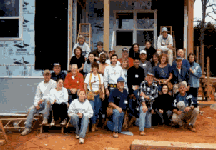 Habitat
for Humanity regularly conducts high profile, blitz builds to
attract media attention. At blitz builds one or more houses are
built in as little as a few hours or as
Habitat
for Humanity regularly conducts high profile, blitz builds to
attract media attention. At blitz builds one or more houses are
built in as little as a few hours or as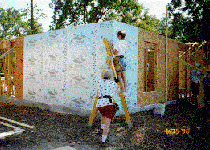 long as several weeks. At blitz builds, a
long as several weeks. At blitz builds, a
focused group of active volunteers from hundreds of different
communities (Figure
39) get comprehensive, real-world energy construction training
from FSEC and other Habitat supporters (Figure
40). The
depth and intensity of this training would be difficult to duplicate
with traditional training approaches or by working with individual
communities at the normal pace of construction. Blitz builds also
bring energy
issues to the media as evidenced by coverage of the 1998 blitz
build by New York's Westminster HFH affiliate (Figure
41) which was covered by CBS This Morning and Bob Vila's Home
Again series.
FSEC staff was invited to discuss energy testing for the show,
set to air in the winter of 1999.
Evaluations from the 1998 Jimmy Carter Work Project (JCWP)
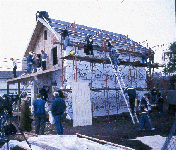 FSEC
surveyed Energy Monitors and construction volunteers involved
in the 1998 JCWP. Results (Figure 42) reveal that 83% of respondents
felt they learned something about energy efficiency, 78% rated
FSEC
surveyed Energy Monitors and construction volunteers involved
in the 1998 JCWP. Results (Figure 42) reveal that 83% of respondents
felt they learned something about energy efficiency, 78% rated
the energy program "Above Average" or "Excellent," and perhaps
most importantly, 70% indicated that they volunteer with their
local affiliate. This again suggests that DOE's influence extends
from the actual
DOE sponsored activity into many communities throughout the country.
1999 Easter Morning Build, Americus, Georgia, March 1999
Design assistance to the Sumpter County-Americus affiliate (Habitat's
headquarter affiliate) began with site planning in 1995. FSEC
subcontractor, Bruce McKendry of WattsRight, participated in a
one-week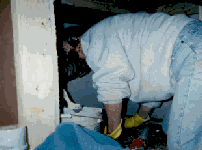
blitz build held by the Sumpter County affiliate teaching volunteers
air sealing (Figure
43) and insulating procedures. At the end of the week blower
door and duct blaster testing provided concrete evidence of
the good work that the volunteers did. Testing serves to validate
the approach and encourage volunteers to implement what they have
learned at their home affiliate.
Training Workshops and Seminars
FSEC has found that workshops conducted in conjunction with other
Habitat functions or promoted by Habitat International draw larger
Habitat attendance than those conducted at Energy related
conferences or as stand alone events. This year, FSEC participated
in three major Habitat training events:
Habitat's Southeastern Regional Conference
Habitat Green Team Leadership Training,
and
Energy Efficiency for Affordable Housing,
one-day workshop at FSEC promoted by Habitat International
Southeastern Habitat for Humanity Conference. Jacksonville FL, October 1998
One 1.5 hour seminar presented energy efficiency basics to a
group of about 40 Habitat decision-makers, such as Construction
Managers, Executive Directors, and Building Committee Chairpersons.
A
second 1.5 hour seminar presented more advanced energy and IAQ
concepts to a similar size audience. Attendees represented affiliates
in Florida, Georgia, and South Carolina. Full scale framing, insulation,
and air sealing details were built and displayed.
Green Team Leadership Training in Chicago at Affordable Comfort '99, April 1999
 A
full day of training for about 40 volunteers from all over the
country. Conceptually, this core group of Green Team leaders will
serve as regional contacts for Habitat affiliates who want to
build more energy
A
full day of training for about 40 volunteers from all over the
country. Conceptually, this core group of Green Team leaders will
serve as regional contacts for Habitat affiliates who want to
build more energy
efficient and environmentally appropriate homes. FSEC provided
training on the basics of air flow, the effects of duct leakage,
how to conduct a duct blaster test, and how to calculate duct
leakage (Figure
44). Mastic and mesh sealing was also introduced.
While FSEC staff serve as a members of the Green Team leadership,
FSEC plays a larger role as a resource for all the Green Team
leaders as well as providing builder option packages discussed
above and
individual consultation to many affiliates not yet supported by
a Green Team member.
Energy Efficiency for Affordable Housing
This one-day workshop held at FSEC at the request of Habitat
International's Department of Construction and Environmental Resources
(who also promoted it in a monthly newsletter) drew about 18
attendees from Florida. Focused on making concrete steps toward
meeting Habitat's challenge of reaching Energy Star, workshop
instructors demonstrated the use of Florida's code compliance
and rating
software, the Florida Energy Gauge, showing how different improvements
impacted the HERS score. Energy improvement guidelines were also
developed and distributed at this event.
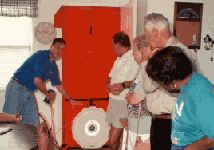 Technical
topics included air conditioning efficiency, window specifications,
insulation, air sealing details, and duct system sealing. Attendees
visited a local Habitat house where two instructors conducted
a
Technical
topics included air conditioning efficiency, window specifications,
insulation, air sealing details, and duct system sealing. Attendees
visited a local Habitat house where two instructors conducted
a
blower door and a duct blaster test (Figure
45).
The hands-on activity reinforced the day's emphasis on sealing
duct systems with mesh and mastic (consistently one of the most
cost-effective energy improvements 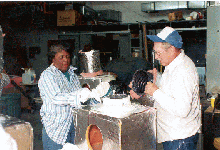 revealed by ratings, simulation analysis, and
revealed by ratings, simulation analysis, and
field research). Working in pairs, participants sealed a flex
duct collar to a duct board box and then a section of flex duct
to the collar (Figure
46). The purpose of the activity was not to train volunteers
to
build duct systems, but to give the participants a personal understanding
of the process and what to look for in a high quality installation.
As might be expected, evaluations indicated the hands-on activity held the greatest value. Four affiliates have submitted plans in pursuit of the Energy Star goal.
Field Evaluation of Energy Conservation Concepts
Structural Insulated Panel Field Project
Most of Habitat's 1400+ American affiliates build wood frame
houses. However, some affiliates are experimenting with other
systems including straw bale construction, ICFs, and SIPs. Sumter
County
Habitat for Humanity, the original affiliate started by Habitat
founder Millard Fuller, partnered with the Department of Energy
and the Structural Insulated Panel Association (SIPA) to build
two SIP houses in
Plains, Georgia. This field project seeks validation of heating
energy savings from SIPs.
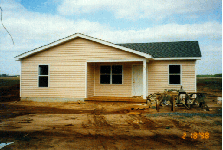 The
affiliate built the two SIP houses and a frame house on three
neighboring lots. The Structural Insulated Panel Association (SIPA)
provided some assistance with the SIP houses. The three houses
were
The
affiliate built the two SIP houses and a frame house on three
neighboring lots. The Structural Insulated Panel Association (SIPA)
provided some assistance with the SIP houses. The three houses
were
intentionally built with their calculated energy performance (HERS
score) similar to each other as seen in Table
5. The frame house (Figure
47) featured energy related details typical for the affiliate
which
resulted in an ACH50 of 5.3. With the home's whole-house fan cover
installed the ACH dropped to 3.9, very good for frame construction.
However, testing results revealed much better performance in the
SIP (Figure 43) houses with a measured ACH50 of 1.8. Though this
indicates a 50% decrease in infiltration, that does not correlate
directly into a 50% heating energy savings since infiltration
determines only
a portion of the total heating energy use. Other factors include
insulation levels, conditioned square footage, window area, number
of occupants, occupancy patterns, use of supplemental heaters,
heater
operation strategy, and indoor temperature. Monitoring equipment
was installed to measure total, heating, and water heating energy
use, as well as indoor and outdoor temperature (Table
5).
A 1995 study of 10 Habitat homes in Florida City, Florida revealed
that the maintained indoor air temperature heavily influences
conditioning energy use (Parker, et al. 1995). Preliminary analysis
suggests that
this may be a significant factor in the Sumter County study. The
three houses' indoor average hourly temperatures and the outdoor
average hourly temperature for December 1998 and January 1999
are
illustrated in Figure 44. Note that the frame house (green) consistently
maintained a higher indoor temperature than the SIP houses (red
and blue). The impact of this considerable difference (average
of 5F) is
accounted for in Figure 45 showing heating energy use (per 1,000
ft2 of conditioned space) as it relates to the indoor-outdoor
temperature difference. Though savings vary from day to day based
on weather,
considering the average indoor-outdoor temperature difference
of 30oF, the SIP houses saved 25% compared to the frame house.
A previous study conducted in Louisville, Kentucky comparing
SIP to frame construction found a 15% savings for the SIP construction
(Rudd, 1997). In that study, the duct systems for both houses
were
located in conditioned spaces. The Plains SIP houses had ducts
in the conditioned space while the frame house had ducts in the
unconditioned attic. The 10% difference in the Plains and the
Louisville findings
are attributed to the differences in duct system locations. Together,
these two studies suggests that homes of 1,200 ft2 and smaller
stand to gain significant energy performance from SIP construction
with
heating energy savings of 15-25% depending on duct location and
average indoor-outdoor temperature differences.
The objective of this task was to work with manufacturers to
produce energy-efficient manufactured homes and to research causes
of, and potential solutions to moisture problems found in some
manufactured
homes. Manufactured housing is defined as HUD code housing. Two
activities were conducted:
Partnership with Palm Harbor Homes (PHH)
Subcontract with the Manufactured Housing
Research Alliance (MHRA)
Partnership with Palm Harbor Homes (PHH)
PHH (www.palmharbor.com) is a leading manufacturer of HUD-code
homes with 16 factories in 8 states producing more than 10,000
homes annually. Five years ago, under the auspices of the EEIH
program, FSEC began collaborating with the PHH factory in Plant
City, Florida, (Figure 46) by conducting diagnostic tests and
infrared camera inspection, and by offering building science advice.
As a result
PHH incorporated return air transfer ducts to minimize pressure
imbalances in the conditioned space and incorporated a metal collar
in the return air grill to reduce return air leakage. PHH also
began offering
a radiant barrier option in Texas homes.
With FSEC guidance, PHH Plant City produced the world's first
two HUD-code Energy Star homes in 1997. The Energy Star homes
had more-efficient heat pumps and a radiant barrier. Side-by-side
tests
show that the Energy Star model saves greater than 33% of cooling
energy. Diagnostic tests revealed that duct leakage in these homes
was reduced by an average of 66% compared with similar new PHH
homes produced without airtight duct systems. This is expected
to save, in Florida on average, 7% of the heating and cooling
energy use. PHH now uses airtight duct construction (Figures 47
and 48) in four
factories in Florida, North Carolina and Oregon, which produce
more than 3,000 homes annually. FSEC personnel visited Florida,
Oregon and Texas plants to conduct duct leakage tests and educate
PHH
plant personnel on benefits of air tight duct construction (energy
savings, better comfort, reduced mold and moisture problems etc.)
It is important to note the magnitude of energy savings (and
consequent pollution prevention and reduced global warming) from
this air tight duct construction activity with Palm Harbor homes.
Even if one
assumes a savings of 5% per home, this results in 3,000 homes
saving 5% or the equivalent of 300 homes saving 50% (the goal
of the Building America program). These numbers are comparable
to actual in
field energy savings accomplished by leading Building America
teams.
FSEC has also assisted in developing Energy Star packages for
more than 50 PHH models manufactured in Alabama, Colorado, Florida,
Kansas, North and South Carolina, Ohio, Oklahoma and Texas. To
date, 18 homes in North Carolina have received Energy Star certificates,
but about 70% of the homes built between January and August 1998
at the Siler City, NC, plant meet Energy Star standards. These
560 homes were sold by Energy Efficient Homes, a subsidiary of
PHH, with a energy usage guarantee. Although these homes are estimated
to meet Energy Star standards, they have not been field tested
for
verification.
Other PHH factories in Alabama, Ohio and Texas are interested in producing Energy Star homes and converting their factories to air tight duct construction.
Manufactured Housing Research Alliance (MHRA)
MHRA with co-funding from HUD and Manufactured Housing Institute,
developed a preliminary guide entitled "Eliminating Moisture Problems
in Manufactured Homes". This documents several case
studies of moisture problems in manufactured housing and provides
checklists for manufacturers, site installers and homeowners to
avoid moisture problems.
Moisture problems generally occur as a result of water leaks,
vapor convection, and/or vapor diffusion. The causes of water
leaks are generally easy to see and understand. Vapor convection/diffusion
problems arise over time and are generally a result of several
items added together: low cooling season set point temperature
by the homeowner (around 70 F) + installation in a hot, humid
coastal climate+
leaky supply ductwork + oversized cooling equipment which doesn't
dehumidify adequately + the presence of vinyl covered wall paper
on exterior walls.
The MHRA document outlines about twenty case studies where moisture
problems were related to the failure of either the floors, walls,
windows, roofs, mechanical system, or duct system. Other case
studies
documented high humidity in the houses or crawl space moisture
problems.
It appears that two to four homes out of 1,000 manufactured homes
have a serious moisture problem. The problems appear to be more
prevalent in newer homes built after 1995. Research needs to continue
on this topic and recommendations need to be developed for manufacturers
as well as for HUD and other builders.
Chandra, Subrato, David Beal, and Brian Fuehrlein, 1999. The
Entry Level Homes Project - A Case Study. IAMOT 1999, Proceedings
of the 8th International Conference on Management of Technology.
Cairo, Egypt. March 15-17, 1999, Part I, pp. 87-96.
Hodgson, A. T., D. Beal, and S. Chandra, 1999. Concentrations
and Sources of Formaldehyde and Volatile Organic Compounds in
Four New Manufactured Houses. Indoor Air 99, Proceedings of
the 8th International Conference on Indoor Air Quality and Climate.
Edinburgh, Scotland. August 8-13, 1999, vol. 4, pp. 119-124. Construction
Research Communications Ltd. London, EC1R 4GB, UK.
Rudd, A. F. and J. W. Lstiburek, 1999. Design Methodology and
Economic Evaluation of Central-Fan-Integrated Supply Ventilation
Systems. Indoor Air 99, Proceedings of the 8th International
Conference on Indoor Air Quality and Climate. Edinburgh, Scotland.
August 8-13, 1999, vol. 5, pp. 25-30.
The Home Front News, My Favorite New Product, July 1998.
Air Conditioning, Heating & Refrigeration News, What's New: Blower Control, September 14, 1998, pp. 24.
Air Conditioning, Heating & Refrigeration News, Fan recycling control offers improved indoor air and comfort for tight houses, September 28, 1998, pp. 30-33.
Energy Design Update, Computer Simulations Look Good for "Cathedralized" Attics, September 1998, pp. 6-10.
Builder, Resources: HVAC Electronic Control, October 1998, pp. 296.
Energy Design Update, Ventilation System Decision Flow Chart, February 1999, pp. 16.
(ACCA) Air Conditioning Contractors Association, 1999. Web page summarizes findings of a Contracting Business magazine survey of 80,000 households. http://www.acca.org/articles/consumer.htm
Cummings, James B. and Neil Moyer, 1995. Reassessment of Airtightness Practices in the Florida Energy Code. Contract Report 793-95. Florida Solar Energy Center. Cocoa, Florida.
Rudd, Armin, 1994. Side-by-Side Evaluation of a Stressed-Skin
Insulated-Core Panel House and a Conventional Stud-Frame House.
Contract Report 664-93. Florida Solar Energy Center. Cocoa,
Florida.
Hodgson, A. T., D. Beal, and S. Chandra, 1999. Concentrations
and Sources of Formaldehyde and Volatile Organic Compounds in
Four New Manufactured Houses. Indoor Air 99, Proceedings of
the 8th International Conference on Indoor Air Quality and Climate.
Edinburgh, Scotland. August 8-13, 1999, vol. 4, pp. 119-124. Construction
Research Communications Ltd. London, EC1R 4GB, UK.
BAIHP Home | Overview | Case Studies | Current Data
Partners | Presentations | Publications | Researchers | Contact Us
Copyright © 2002 Florida Solar Energy Center. All Rights Reserved.
Please address questions and comments regarding this web page to BAIHP Master